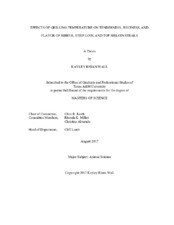| dc.description.abstract | The objective of this study was to characterize the impact of grilling temperature on ribeye, top loin and top sirloin steaks. Boneless ribeye rolls, top loin and top sirloin butt subprimals (n = 16 each, 48 total) were purchased from a local meat supplier. After aging 21 d post-processing, 2.54-cm-thick steaks were hand cut and randomly assigned a grilling temperature treatment (177°C, 205°C, or 232°C), vacuum-packaged, and frozen at -10°C until testing. Steaks were grilled to an internal temperature of 71°C on a commercial flat top grill set at 177° C, 205° C, or 232° C. Consumers (n = 80) were served nine samples and prompted to rate their liking of overall, tenderness, juiciness, appearance, and flavor on a 9-point hedonic scale. Steaks cooked for Warner-Bratzler shear force were held over night at 4° C before removing six cores 1.3 cm in diameter from each steak. Steaks were also cooked and served to a sensory panel trained on flavor and texture attributes. Samples from the steaks used for trained sensory panel analysis were quick-frozen in liquid nitrogen and stored at -80° C for GC/MS – olfactory analysis. Results were analyzed as a 3x3 factorial completely randomized design. No differences (P > 0.05) in consumer overall, tenderness, juiciness, appearance, and flavor liking were detected between steak type or grill temperature. The center color of ribeye steaks was lighter (P < 0.05) than top loin and top sirloin steaks. The ribeye steaks also had a greater (P < 0.05) hue angle than top sirloin steaks. Strip loin steaks had 0.27 kg less shear force (P < 0.05) than ribeye and top sirloin steaks. Ribeye and strip loin steaks received greater (P < 0.05) muscle fiber tenderness and less (P < 0.05) connective tissue scores. Grill surface temperature had no effect (P > 0.05) on trained panel tenderness scores. Of the volatiles present during an aroma event (n = 67), pyrazine compounds were most influenced by grill surface temperature. The tenderness and juiciness of steaks grilled at differing temperatures were not perceived to be different by consumers; however, grilling temperature impacted the flavor of the final product by generating more pyrazine compounds. | en |


